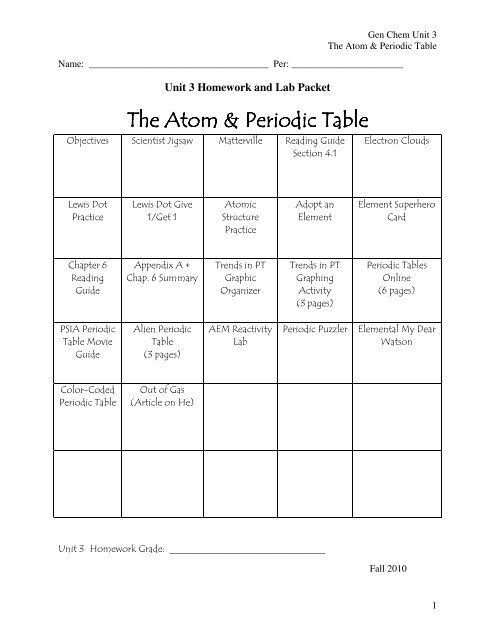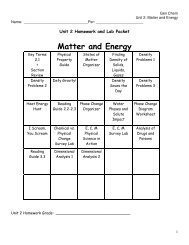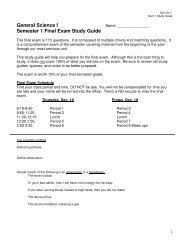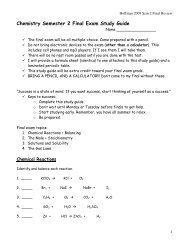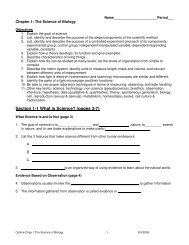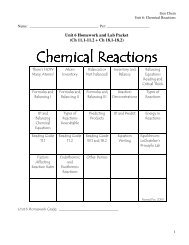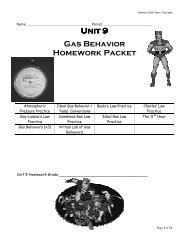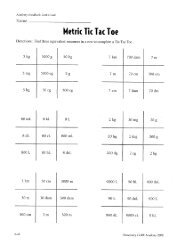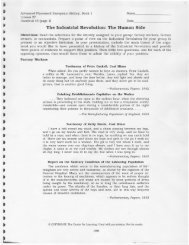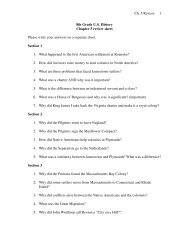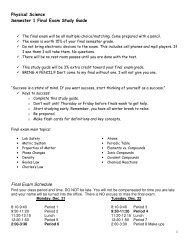The Atom & Periodic Table The Atom & Periodic Table
The Atom & Periodic Table The Atom & Periodic Table
The Atom & Periodic Table The Atom & Periodic Table
Create successful ePaper yourself
Turn your PDF publications into a flip-book with our unique Google optimized e-Paper software.
Gen Chem Unit 3<strong>The</strong> <strong>Atom</strong> & <strong>Periodic</strong> <strong>Table</strong>Unit 3 Overall Goals:Understand and apply knowledge of the structure of atoms.Understand and apply knowledge of the structure and properties of matter.After completing this unit, you should be able to understand and explain the following.1. Know the development of the atomic models and the scientists responsible for them.2. Identify atoms and ions by mass number, atomic number, charge, number of electrons,protons, and neutrons.3. Define isotope.4. Define periodicity and be able to explain how it relates to the periodic table.5. Understand the principles used to structure the periodic table.6. Know the name of the scientist who is accredited with creating the periodic table.7. Understand and know the common names and terms related to the periodic table of elements(ex: family, group, period, metalloid, etc).8. Know the terms and properties related to metals, non-metals, and metalloids.9. Understand the energy levels of electrons for the first eighteen elements.10. Know the term valence electrons and determine the number of valence electrons by usingthe periodic table.11. Be able to write the Lewis dot structure for the elements based on their location on theperiodic table.12. Know the trends of atomic radius, ionization energy, atomic mass, reactivity and number ofvalence electrons.13. Know the major families on the periodic table and the trends they follow.2
Gen Chem Unit 3<strong>The</strong> <strong>Atom</strong> & <strong>Periodic</strong> <strong>Table</strong>Scientist Description of research Drawing of their modelJohn Dalton (p. 101-102; 128-129)JJ Thompson (p.104-105; 128-129)Ernest Rutherford (p.106-108; 128-129)Neils Bohr (p.128-129)Erwin Schroedinger (from notes)3
Gen Chem Unit 3<strong>The</strong> <strong>Atom</strong> and <strong>Periodic</strong> <strong>Table</strong><strong>The</strong> <strong>Atom</strong>s Family4
Gen Chem Unit 3<strong>The</strong> <strong>Atom</strong> and <strong>Periodic</strong> <strong>Table</strong>5
Gen Chem Unit 3<strong>The</strong> <strong>Atom</strong> and <strong>Periodic</strong> <strong>Table</strong>Reading GuideSection 4.1 (p. 100-103)1. What is an atom?2. What did Democritus believe about the structure of an atom?3. John Dalton was one of the first scientists to list ideas about the atom. List his four ideasbelow in your own words.A.B.C.D.4. What instrument can be used to observe individual atoms?5. According to Dalton’s theory, is it possible to convert atoms of one element into atoms ofanother? Briefly explain.6. EXRA CREDIT: Read the “Inquiry Activity” on page 100. Conduct the simple experimentat home. Be sure to record your observations and answer the “Think About It” questions.6
Gen Chem Unit 3<strong>The</strong> <strong>Atom</strong> and <strong>Periodic</strong> <strong>Table</strong>Electron CloudsUse the information provided for each element to complete the diagram. First, draw theelectrons in their proper shells. Second, place the correct numbers in the nucleus to indicate thenumber of protons and the number of neutrons.1. Sulfur: atomic number 16 4. Sodium: atomic number 11mass number 32 mass number 23PNPN2. Beryllium: atomic number 4 5. Potassium: atomic number 19mass number 9 mass number 39PNPN3. Nitrogen: atomic number 7 6. Argon: atomic number 18mass number 14 mass number 40PNPN7
Gen Chem Unit 3<strong>The</strong> <strong>Atom</strong> and <strong>Periodic</strong> <strong>Table</strong>8
Gen Chem Unit 3<strong>The</strong> <strong>Atom</strong> and <strong>Periodic</strong> <strong>Table</strong>Lewis Dot Structure PracticeFill in the following section of the periodic table with the symbols of the first 18 elements. <strong>The</strong>n,add the electron dots to complete the Lewis dot structures.1A 2A 3A 4A 5A 6A 7A 8A1. What generalization can be made about the Lewis dot structures in a group (column) ofelements?________________________________________________________________________________________________________________________________________________2. Define valence electrons.________________________________________________________________________3. Why do the noble gases not react?________________________________________________________________________________________________________________________________________________4. Hydrogen can be considered an alkali metal (Group 1A) or a halogen (Group 7A). Why?________________________________________________________________________________________________________________________________________________9
Gen Chem Unit 3<strong>The</strong> <strong>Atom</strong> and <strong>Periodic</strong> <strong>Table</strong>Lewis Dot Give One/Get OneDirections: In the “Give one” column below, draw a Lewis Dot structure for ONE of theatoms listed. <strong>The</strong>n, meet with your partner, and teach them your atom. Your partnerwill then teach you their atom. You should write this in your “Get one” column.Elements Give One Get oneLithium, Sodium, orPotassiumBeryllium, Magnesium, orCalciumBoron, Aluminum, orGaliumCarbon, Silicon, or TinNitrogen, Phosphorus, orBismuthOxygen, Sulfur, orSeleniumFluorine, Chlorine, orBromineHelium, Neon, or Krypton10
Gen Chem Unit 3<strong>The</strong> <strong>Atom</strong> and <strong>Periodic</strong> <strong>Table</strong><strong>Atom</strong>ic Structure Practice<strong>The</strong>re are three subatomic particles. Protons, neutrons, and electrons.1. Which of these have substantial mass? _____________________________________2. Which of these have electromagnetic charge? ________________________________For this page, ASSUME CHARGE IS ZERO.Name Symbol <strong>Atom</strong>ic # Mass # Protons Neutrons Electrons ChargeLithium-7Lithium-9Phosphorus-31Oxygen-16Boron-11Sodium-23Nitrogen-14Aluminum-27Argon-40Argon-39Argon-38Magnesium-24Sulfur-33Phosphorus-34Carbon-14Beryllium-9Ba 13622 4126 50Al 1415 3090 144235 14344 3211
For this page, do NOT assume the charge is zero.Gen Chem Unit 3<strong>The</strong> <strong>Atom</strong> and <strong>Periodic</strong> <strong>Table</strong>Name Symbol <strong>Atom</strong>ic # Mass # Protons Neutron Electrons ChargeLead-207 +4Calcium-40O 2- 18 -218Silver-109 46Sn +4 6837 17 1819 21 +124 24 21Al +3 26107 60 +115 16 18-1056 +232 18 -345 18 +3Iron-55 +3Iron-54 24Ag + 10927 57 2480 120 +1V 5+ 49Bromine-81Bromine-82Barium-138Tellurium-12752 42 +6-212
Gen Chem Unit 3<strong>The</strong> <strong>Atom</strong> and <strong>Periodic</strong> <strong>Table</strong>Adopt-an-ElementRequirements: In this activity, you will be conducting research on your specific element. Youwill then use this information to create an advertisement for that element.1. Complete an “Adopt-an-Element” information sheet.You may use a variety of reference sources. Possible ideas are encyclopedias (book orweb-based), textbooks, the Internet, etc. Information sheets must be NEAT and CONTAIN ALLTHE INFORMATION. You need to include a list of your sources that you used (at least 2 arerequired).2. Create an advertisement for your element.<strong>The</strong> advertisement must include the element’s name, symbol, atomic number, atomicmass, cost, a unique use for the element, and an advertising slogan that describes one or more ofits important uses or qualities. Advertisements must be neat, colorful, and contain all theinformation listed above. You may add pictures that relate to your advertisement theme.Be sure to include:33 74.9AsArsenicArsenic’s a sure fire wayto deal with a nasty rat.It works better thanA mean old cat!Use = rat poisoningCost = $3.20 for 1 gramJohn Smith• Element’s symbol• Element’s name• <strong>Atom</strong>ic number• <strong>Atom</strong>ic mass• Ad slogan• Cost• Unique use• Your nameYou may add pictures or drawingsthat illustrate the varioususes for your element.Your add must follow the sameformat as this example!!A list of periodic table sites is available on:THE SCIENCE SPOThttp://sciencespot.net/Go to KID ZONE, then choose CHEMISTRY LINKS13
Gen Chem Unit 3<strong>The</strong> <strong>Atom</strong> and <strong>Periodic</strong> <strong>Table</strong>Adopt-an-ElementInformation SheetElement Name ______________________________________Symbol ______________________<strong>Atom</strong>ic Number __________________<strong>Atom</strong>ic Mass __________________# of Protons _________ # of Neutrons _________ # of Electrons _________Melting Point _________ o C Boiling Point _________ o C Normal phase __________Cost = ____________________ for ______________________Classification: _____ nonmetal _____ metal _____ metalloidMy element belongs to the ______________________ family.Origin of name ___________________________________________________________Discovered by ______________________________________________ in ___________Interesting Info: (important uses, interesting facts, common compounds, etc)1.2.3.4.5.Sources: (at least 2)1.2.14
Reading Guide: Chapter 6 (p. 154-178; Appendix A)Gen Chem Unit 3<strong>The</strong> <strong>Atom</strong> and <strong>Periodic</strong> <strong>Table</strong>1. What does periodicity mean?PERIODIC(ity)_____________________________________________________________________________________________________________________________2. How did Mendeleev group the elements them in his version of the periodic table?____________________________________________________________________3. How were columns arranged according to Mendeleev?____________________________________________________________________4. How were rows arranged according to Mendeleev?____________________________________________________________________5. <strong>The</strong> Modern <strong>Periodic</strong> table has one similarity to Mendeleev’s. What is it?____________________________________________________________________6. How can elements with a higher atomic mass come before ones with a smaller one?____________________________________________________________________7. Define:a. Periodb. Group (family)c. Noble Gas8. Place a check next to each of the properties of most metals.___reflect light ___conduct heat ___conduct electricity ___brittle___hard (solid) ___gases ___high melting point ___malleable9. Where are the transition metals found on the periodic table?_____________________________________________________________________10. Why is it useful to combine different metals together to make alloys?________________________________________________________________________________________________________________________________________________15
11. Place a check next to each of the properties of most non-metals.Gen Chem Unit 3<strong>The</strong> <strong>Atom</strong> and <strong>Periodic</strong> <strong>Table</strong>___poor conductor ___dull ___brittle ___malleable___solids ___gases ___electrons are held tightly by the nucleus12. What two elements make up most of Earth’s atmosphere? ________________________AND ______________________13. What is special about silicon?14. What metal is used to make wire? ________________________15. What are the two ingredients used to make steel?____________________ AND ___________________16. Why metal is used to prevent rusting? ________________________17. What is the only non-metal which is a liquid at room temperature?______________________________18. What element is used in lasers? ____________________19. What two elements are used to make halogen lamps?_________________ AND ________________16
Gen Chem Unit 3<strong>The</strong> <strong>Atom</strong> and <strong>Periodic</strong> <strong>Table</strong>Appendix A and Chapter 6 (Summary)17
Gen Chem Unit 3<strong>The</strong> <strong>Atom</strong> and <strong>Periodic</strong> <strong>Table</strong>Questions:1. Who created the first periodic table of elements?2. How many elements were known at the time of the first periodic table?3. How many elements are known today (see the periodic table on the other side)?4. What properties did Mendeleev use to categorize his elements?5. What two problems did Mendeleev run into while categorizing his elements?6. What two properties are used to categorize elements on the modern periodic table?18
Gen Chem Unit 3<strong>The</strong> <strong>Atom</strong> and <strong>Periodic</strong> <strong>Table</strong>Trends in <strong>Periodic</strong> <strong>Table</strong> Graphic Organizer19
Gen Chem Unit 3<strong>The</strong> <strong>Atom</strong> and <strong>Periodic</strong> <strong>Table</strong>Trend Definition Going downa group<strong>Atom</strong>ic radiusGoing left toright across aperiodReason for TrendReactivityNMNMNMIonizationEnergyMMMDraw the above trends onto the periodic table on page 18.Use a different color for each trend.Red= <strong>Atom</strong>ic radiusBlue= ReactivityOrange= Ionization Energy20
Gen Chem Unit 3<strong>The</strong> <strong>Atom</strong> and <strong>Periodic</strong> <strong>Table</strong>Trends in the <strong>Periodic</strong> <strong>Table</strong> Graphing Activity<strong>The</strong> arrangement of elements in the periodic table reveals many important trends, orpatterns, in the properties of elements. Many of the trends shown by the table are periodic. Thatis, they repeat within the table. For example, a periodic trend may involve low values at the topof a group, high values at the bottom, and low, values once again at the top of the next group.Recall that the atomic number of an element is equal to the number of protons in thenucleus. <strong>The</strong> atomic mass is the average number of protons and neutrons in the nucleus of anelement. <strong>Atom</strong>ic radius is the distance from the center of an atom to the outermost electrons ofthe atom. <strong>The</strong> first ionization energy of an element is the energy needed to remove the mostloosely help electron of an atom of the element.Directions: You will be making three graphs in this assignment1. Using the periodic table that follows, make a graph of ATOMIC MASS vs. ATOMICNUMBER using the atomic number of 3 to 20 only. Use a different color for each period of theperiodic table. When all the points are plotted, draw a smooth curve for each period with adifferent color. DO NOT CONNECT THE DIFFERENT PERIODS.2. Prepare a graph of ATOMIC RADIUS vs. ATOMIC NUMBER, using the atoms of 3 through20 only. Use a different color for each period of the periodic table. When all the points areplotted, draw a smooth curve for each period with a different color. DO NOT CONNECT THEDIFFERENT PERIODS.3. Prepare a graph of FIRST IONIZATION ENERGY vs. ATOMIC NUMBER, using the atomicnumbers of 3 to 20 only. Use a different color for each period of the periodic table. When allthe points are plotted, draw a smooth curve for each period with a different color. DO NOTCONNECT THE DIFFERENT PERIODS.21
Gen Chem Unit 3<strong>The</strong> <strong>Atom</strong> and <strong>Periodic</strong> <strong>Table</strong>22
Gen Chem Unit 3<strong>The</strong> <strong>Atom</strong> and <strong>Periodic</strong> <strong>Table</strong>Graphing Trends in <strong>Periodic</strong> <strong>Table</strong> Questions: Use your graphs to answer the followingquestions.1. What happens to atomic mass when going across each period?2. What happens to atomic mass when going down a group?3. What happens to atomic radius when going across each period?4. What happens to atomic radius when going down a group?5. What patterns do you notice on <strong>Atom</strong>ic Radius vs. <strong>Atom</strong>ic Number graph?6. What happens to first ionization energy when going across each period?7. What happens to the first ionization energy when going down a family?8. What pattern do you notice on the First Ionization Energy vs. <strong>Atom</strong>ic Number graph?23
Gen Chem Unit 3<strong>The</strong> <strong>Atom</strong> and <strong>Periodic</strong> <strong>Table</strong>24
Gen Chem Unit 3<strong>The</strong> <strong>Atom</strong> and <strong>Periodic</strong> <strong>Table</strong><strong>Periodic</strong> <strong>Table</strong>s OnlinePart 1:• Go to http://sciencespot.net• Click on Kid Zone• Click on Matter & <strong>Atom</strong>s in the Chemistry section• Click on CHEMystery link• Click on the <strong>Periodic</strong> <strong>Table</strong> of Elements link on the left hand side of the page1. Using a blue, orange, purple, green, and red colored pencil, color code and label the followingcategories to match the periodic table online:- Representative metals- Transition metals- Inner transition metals- Metalloids- Nonmetals25
Gen Chem Unit 3<strong>The</strong> <strong>Atom</strong> and <strong>Periodic</strong> <strong>Table</strong>Part 2:• Go to http://sciencespot.net• Click on Kid Zone• Click on <strong>Periodic</strong> <strong>Table</strong> Sites in the Chemistry section• Click on Chemical Elements.com linkUse the menu on the left-hand side of the screen to answer the following questions.1. Where are the metalloids found on the periodic table?________________________________________________________________________2. Which elements are metalloids? List their symbols_____ _____ _____ _____ _____ _____ _____3. What are two uses for metalloids?________________________________________________________________________4. Where are the noble gases found on the periodic table?________________________________________________________________________5. Which elements are classified as noble gases? List their symbols._____ _____ _____ _____ _____ _____6. Which elements are classified as nonmetals? List their symbols._____ _____ _____ _____ _____ _____ _____7. What does the term “halogen” mean?_______________________________________________________________________8. Which elements are classified as halogens? List their symbols._____ _____ _____ _____ _____9. Where do you find the transition metals on the periodic table?________________________________________________________________________10. What is unique about the location of the valence electrons in the transition metals?________________________________________________________________________26
Gen Chem Unit 3<strong>The</strong> <strong>Atom</strong> and <strong>Periodic</strong> <strong>Table</strong>Part 3:• Go to www.chem4kids.com• Use this website as a review of the atom and the periodic table.• Your assigned element is the element that has the same atomic number as your birthday(day of the month)o Ex: my birthday is November 20, so my element is Calcium (atomic #=20)Prior Knowledge Questions1. What is an element?________________________________________________________________________2. On the periodic table, what are the rows called? ______________________________What do they all have in common? ___________________________________________3. What are the columns called? ____________________________________________What so they all have in common? ___________________________________________4. What is an atom? ______________________________________________________5. What is a nucleus? _____________________________________________________6. Define ATOMIC NUMBER: ____________________________________________7. Define ATOMIC MASS: _______________________________________________MY ELEMENT IS (from Part 3 instructions): _________________________________1. Write a brief description of your element.2. Who found your element and when?27
Gen Chem Unit 3<strong>The</strong> <strong>Atom</strong> and <strong>Periodic</strong> <strong>Table</strong>In the upper left hand corner of the ELEMENT PAGE, there is a menu with the choices:“Say it” “Shell Info” or “Bond With It”Use these choices and this menu to answer the following questions3. What is your element’s atomic number?4. How many electrons do you have when it has a neutral charge?5. How many protons do you have?6. What is your average atomic mass?7. List three ways that your element is used.8. Draw the Bohr diagram of your element with all of its shells. Make sure to label the electronsand nucleus.Part 4Directions: go to the website http://www.colorado.edu/physics/2000/applets/a2.htmla. Make sure that you are on David’s Whizzy <strong>Periodic</strong> <strong>Table</strong>.b. Once there, click on Hydrogen (H).c. Choose the Nuclear ViewYou will be completing the follow chart as you search this website.28
ColorParticleRedNameChargeGen Chem Unit 3<strong>The</strong> <strong>Atom</strong> and <strong>Periodic</strong> <strong>Table</strong>BlackYellow &Pink1. What does the red particle represent? Fill in the red particle row in the chart above.2. What charge does the red particle have? ___________________________3. How many are there in Hydrogen? ________________________________Now click on the Shell View.1. What does the pink particle represent? Fill in the pink particle row in the chartabove.2. What charge does it have? _______________________________________3. How many are there? ___________________________________________Now choose Neon, and choose the Nucleus View.4. What do the black particles represent? Fill in the black particle row in the chartabove.5. How many red particle are there in Neon? ___________________________6. What is Neon’s atomic number? ___________________________________Now choose Shell View.7. How many pink and yellow particles are there in Neon? _________________8. How many pink particles are in the first shell of Neon? __________________9. How many yellow particles are in the second shell of Neon? _____________10. How much Neon would $100.00 get you? ___________________________29
Gen Chem Unit 3<strong>The</strong> <strong>Atom</strong> and <strong>Periodic</strong> <strong>Table</strong>11. What is Neon used for? _________________________________________Now choose Beryllium, and choose the Nucleus View.12. How many black particles are there in Beryllium? _____________________13. How many red particles are there in Beryllium? ______________________Now chose the Shell View.14. How many pink and yellow particles are there in Beryllium? _____________15. What is Beryllium’s atomic number? _______________________________16. How many protons does Beryllium have in its nucleus? ________________17. How many electrons does Beryllium have in its shell? _________________18. How many electrons are in the first energy level in Beryllium? __________19. How many electrons are in the second energy level in Beryllium? ________20. How much Beryllium could you buy with $100? ______________________21. What is Beryllium used to make? _________________________________30
Gen Chem Unit 3<strong>The</strong> <strong>Atom</strong> and <strong>Periodic</strong> <strong>Table</strong>Alien <strong>Periodic</strong> <strong>Table</strong>Introduction:Imagine that scientists have made radio contact with life on a distant planet. <strong>The</strong> planet iscomposed of many of the same elements as are found on Earth. However, the inhabitants of theplanet have different names and symbols for the elements. <strong>The</strong> radio transmission gave data onthe known chemical and physical properties of 30 elements that belong to Groups 1, 2, 13, 14,15, 16, 17, and 18. You need to place the elements into a blank periodic table based on theseproperties.Problem: Where do the alien elements fit in the periodic table?Procedure:1. Listed below are data on the chemical and physical properties of the 30 elements. Write theelements in their proper position in the blank periodic table.2. Once you have determined the proper position for each element, then write the symbol in thecorrect place. <strong>The</strong> noble gases are bombal (Bo), wobble (Wo), jeptum (J), and logon (L). Among thesegases, wobble has the greatest atomic mass and bombal the least. Logon is lighter thanjeptum.<strong>The</strong> most reactive group of metals are xtalt (X), byyou (By), chow (Ch), and quackzil(Q). Of these metals, chow has the lowest atomic mass. Quackzil is in the same periodas wobble.Apstrom (A), vulcania (V), and kratt (Kt) are nonmetals whose atoms typically gain orshare one electron. Vulcania is in the same period as quackzil and wobble.<strong>The</strong> metalloids are ernst (E), highho (Hi), terriblum (T), and sississ (Ss). Sississ is themetalloid with the greatest atomic mass. Ernst is the metalloid with the lowest atomicmass. Highho and terriblum are in Group 14. Terriblum has more protons than highho.Yazzer (Yz) touches the zigzag line, but it's a metal, not a metalloid.<strong>The</strong> lightest element of all is called pfsst (Pf). <strong>The</strong> heaviest element in the group of 30 iseldorado (El). <strong>The</strong> most chemically active nonmetal is apstrom. Kratt reacts with byyouto form table salt.<strong>The</strong> element doggone (D) has only 4 protons in its atom.Floxxit (Fx) is important in the chemistry of life. It forms compounds of long chains ofatoms. Rhaatrap (R) and doadeer (Do) are metals in the fourth period, but rhaatrap is lessreactive than doadeer.Magnificon (M), goldy (G), and sississ are all members of Group 15. Goldy has fewertotal electrons than magnificon.31
Gen Chem Unit 3<strong>The</strong> <strong>Atom</strong> and <strong>Periodic</strong> <strong>Table</strong>Urrp (Up), oz (Oz), and nuutye (Nu) all gain 2 electrons when they react. Nuutye isfound as a diatomic molecule and has the same properties as a gas found here in Earth'satmosphere. Oz has a lower atomic number than urrp.<strong>The</strong> element anatom (An) has atoms with a total of 49 electrons. Zapper (Z) and pie (Pi)lose two electrons when they react. Zapper is used in flashbulbs.Analysis Questions:1. List the name of each alien element and the Earth element that it represents. Do this for all30 elements used in this activity. (write small)2. Were you able to place some elements within the periodic table with just a single clue?Explain your answer using two examples from the activity.3. Why did you need two or more clues to place other elements? Explain your answer using onespecific example from the activity.4. Why could you use clues about atomic mass to place elements, even though the periodictable is based on atomic number?32
Gen Chem Unit 3<strong>The</strong> <strong>Atom</strong> and <strong>Periodic</strong> <strong>Table</strong>Alien <strong>Periodic</strong> <strong>Table</strong>1 2 13 14 15 16 17 1833
Gen Chem Unit 3<strong>The</strong> <strong>Atom</strong> & <strong>Periodic</strong> <strong>Table</strong>34
Gen Chem Unit 3<strong>The</strong> <strong>Atom</strong> & <strong>Periodic</strong> <strong>Table</strong>Alkaline Earth Metals Reactivity LabMaterials:Spot (well plate) potassium chromate magnesium nitratecalcium nitrate strontium nitrate barium nitratepotassium carbonate potassium sulfateCaution: <strong>The</strong> chemicals used in this lab can cause severe damage to your eyes very quickly. Donot let you goggles off your face for a moment. Some of the chemicals have very corrosiveodors. Do not smell any of these chemicals directly.Precipitate: Solid that forms when two liquids are mixed.MORE PRECIPITATES = MORE REACTIVEProcedure:1. Prepare the following table in your lab book. Do NOT include the arrows.<strong>Table</strong> 1: Reactivity of Alkaline Earth MetalsAlkaline EarthMetalMagnesium Nitrate(write formula)3 dropsCalcium Nitrate(write formula)3 dropsStrontium Nitrate(write formula)3 dropsBarium Nitrate(write formula)3 dropsPotassiumCarbonate3 dropsPotassium Sulfate3 dropsPotassiumChromate3 drops2. Get a well plate-set it up just like the above table-the plate should contain 3 columns and 4 rows3. With chalk, label you lab table to that the well plate is labeled EXACTLY like your table.4. Add the appropriate number of drops to each well, according to the table above.35
Gen Chem Unit 3<strong>The</strong> <strong>Atom</strong> & <strong>Periodic</strong> <strong>Table</strong>5. In each box of your data table record:• Reaction or no reaction• Color reaction• Strong precipitate or Weak precipitateQuestions1. List the Alkaline Earth Metals tested today in order of their chemical reactivity (most reactiveto least reactive).2. How does the order listed above compare to the trusty periodic table?3. Group 1A in the <strong>Periodic</strong> <strong>Table</strong> is known as the Alkali Metals. Based on this experiment,predict the reactivity of all the elements in Group 1A of the periodic table. List them from mostreactive to least reactive.Conclusion:1. purpose achieved? Proof with data2. What affected your data? Errors or mistakes36
Gen Chem Unit 3<strong>The</strong> <strong>Atom</strong> & <strong>Periodic</strong> <strong>Table</strong><strong>Periodic</strong> PuzzlerCan you place these elements in their proper positions on the <strong>Periodic</strong> <strong>Table</strong> without knowingtheir identity? Instead of the usual chemical symbol, a code letter represents each element.Some clues to the element’s identity are listed below. <strong>The</strong> elements fall into these families orgroups:JKQ WNVG IAL EPFZ YBR ODS CXU THMPlace each code letter in its proper space in the table below, and then indicate the actual chemicalsymbol that corresponds to each letter.ElementsV is an inert gas.E is an alkali metal.U is a halogen.D is an element with 5 valence electrons.J is an alkaline earth metal.T is found in period 4.R is found in group 13.A has six protons in its nucleus.R has an atomic number one less than A.O has an atomic number one more than A.S has 18 more protons than D.F has only one proton.Y has atoms that are heavier than the atomsof B.Ihas the largest atomic number in itsgroup.C has atoms that are heavier that U, butlighter than X.V has one more proton than U.H has the smallest atomic number in itsgroup.G has two protons.N is in the third period.J is in the second period.Q has an atomic mass greater than J butless than KE has an atomic number less than Z butgreater than P.Z has more protons than other elements inits group.U is in the second period.37
Gen Chem 1 Unit 3<strong>Atom</strong> + <strong>Periodic</strong> <strong>Table</strong>1 2 13 14 15 16 17 18Groups and FamiliesUse your periodic table to obtain the name and symbol of the element being described.CHARACTERISTIC NAME SYMBOL1. Alkali metal in the fourth period.2. Inner transition metal in period 7 thatstarts with the letter "E."3. Halogen in the third period.4. Member of the oxygen family that is ametal.5. Second period metalloid.6. First transition metal in period four.7. Nonmetal in period six.8. Noble gas in period five.9. Only halogen that is naturally a liquid.38
Gen Chem 1 Unit 3<strong>Atom</strong> + <strong>Periodic</strong> <strong>Table</strong>Elemental, My Dear Watson<strong>The</strong> famous detective Sherlock Holmes used all kinds of clues to solve the mysteries. Like anygood detective, he knew the value of fingerprints, because no two people have the samefingerprints. In a way, atomic numbers are like fingerprints, because no two elements havethe same atomic number. In this activity you will be a chemical detective who tracks downelements by deducing their atomic numbers. You will need to use your periodic table tocomplete this activity.1. <strong>The</strong> atomic number of element X is six less than the atomic number of Y.Element Y is one of the elements that make up water. What are elements X and Y?Element X = Element Y =2. To find element Z, start at the beginning of Period 2 on the <strong>Periodic</strong> <strong>Table</strong>.Move to the right until you come to an element whose atomic number is six more thanthe atomic number of the first element in the period. What is element Z?Element Z =3. Element D loses two electrons in a chemical reaction.Now it has the same number of electrons as neon. What is element D?Element D =4. If the atomic numbers of calcium and beryllium are added together, you will find thiselement. What is the element?Element =5. This metal has an atomic number that some people this is unlucky.What is the element and the atomic number?Element = <strong>Atom</strong>ic Number =6. Add together the atomic number of the first three noble gases, and you’ll have the atomicnumber of this element. What is the element and the atomic number?Element = <strong>Atom</strong>ic Number =39
Gen Chem 1 Unit 3<strong>Atom</strong> + <strong>Periodic</strong> <strong>Table</strong>7. <strong>The</strong> atomic number of element J is greater than the atomic number of platinum but lessthan the atomic number of lead. Its atomic number is divisible by four. What is element J?Element =8. Element Q has an atomic number less than that of calcium.Element Q has an atomic number three times that of the first nonmetal in the carbonfamily. What is element Q? And what is the atomic number?Element = <strong>Atom</strong>ic Number =9. Element R can be found in the halogen family.When element R gains one electron it has the same number of electrons as a noble gas.This noble gas has eighteen protons. What is element R?Element R =10. I am element that needs to lose two electrons to become stable.I also can be used to make your teeth strong and last a long time.What element am I? And what is my atomic number? And what family do I belong to?Element =<strong>Atom</strong>ic Number = _______Family =11. Element O has an atomic mass less than two hundred.When musicians hit it big they receive this type of record.And of course it is my favorite precious metal. What is element O? And what is theatomic number?Element = <strong>Atom</strong>ic Number =12. Element B is found in the atmosphere.This element is needed for plants, both day and night.And element B has an atomic number half that of silicon. What is element B?Element =40
Color-Coded <strong>Periodic</strong> <strong>Table</strong> ActivityGen Chem 1 Unit 3<strong>Atom</strong> + <strong>Periodic</strong> <strong>Table</strong>Directions: Be sure to follow all instructions carefully and completely! Use your textbook andany other resources to help you complete the periodic table.6. Draw a RED diagonal line through the elements that exist as a gas at room temperature.7. Draw a BLUE diagonal line through the elements that exist as a liquid at room temperature.8. Draw HEAVY BLACK LINE down the staircase that separates the metals from thenonmetals.9. Draw a DIAGONAL BLACK LINE from the upper left to the lower right through Astatine (85).10. Lightly shade all the metalloids orange, including the lower portion of Astatine (85).11. Use the following colors to identify the various sections of the periodic table.a. Alkali Metals = greenb. Alkaline Earth Metals = brownc. Halogens = pinkd. Noble Gases = yellowe. Transition Metals = purplef. Lanthanide Series = red do in the lower right cornerg. Actinide Series = blue dot in the lower right corner12. Make a color key in the large open region showing all the colored groups assigned in # 11.13. Answer the following question below (these should be review):a. Define the following vocabulary words: period, group, atomic number, atomic mass,and isotope.b. What are the characteristics that make an element a metal, nonmetal, and ormetalloid?c. List all of the information that can be found in every box on the periodic table.d. Make a list of reasons for why you would need to use the periodic table.41
Gen Chem 1 Unit 3<strong>Atom</strong> + <strong>Periodic</strong> <strong>Table</strong>42
Gen Chem 1 Unit 3<strong>Atom</strong> + <strong>Periodic</strong> <strong>Table</strong>43
1. Make a Data <strong>Table</strong> Showing the recent rise in the price of heliumGen Chem 1 Unit 3<strong>Atom</strong> + <strong>Periodic</strong> <strong>Table</strong>2. Why is the price of helium rising?3. How do they get helium? Name two ways.4. What does the word dwindling mean in the passage?5. Name 4 uses for helium6. What does the word inert mean in the passage?44


